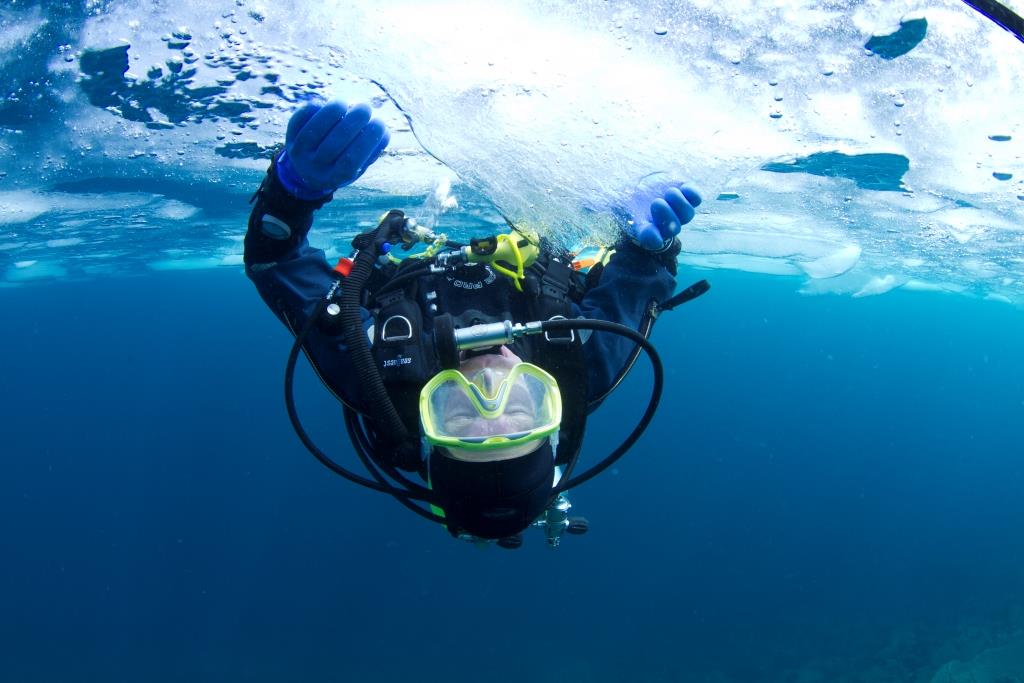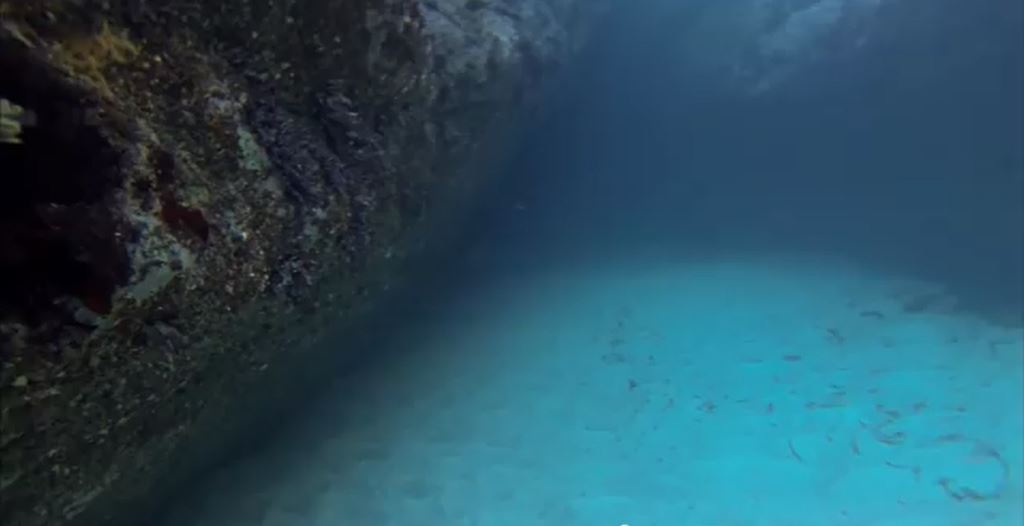Diving
Diving
Click on images to enlarge
I couldn't wait to dive - a photo of me in New Zealand in the summer of 1966 aged three with cellophane mask, toy garden rake snorkel and rubber glove fins.
I became fascinated with diving at a very early age when we lived by the sea in New Zealand, and I first read articles on shipwrecks and underwater exploration in National Geographic magazine. After we returned to Canada I began training to dive at the youngest age then allowed, 15, with the Association of Canadian Underwater Councils (ACUC), beginning my course in the autumn of 1977 and passing my check-out dives the following summer. As well as ACUC I qualified with the Confederation Mondiale des Activites Subacquatiques (CMAS), and later also with the British Sub-Aqua Club (BSAC). The ACUC course was very similar to the BSAC course at the time, extending over the best part of a year and therefore allowing a thorough understanding of diving theory as well as advanced skills training nowadays covered by separate courses after qualification. I was fortunate to have an excellent instructor, Tom D'Entremont, as well as a dive buddy, Steve Aitken, who had trained with me from the outset and was my companion for almost all of my dives over the next two years in Canada.
I spent my summer’s savings from working on a farm buying the Poseidon regulator that I still use today. We dived on shipwrecks at Tobermory in Lake Huron as well as in flooded quarries, including dives under ice. The equipment on our first dives might be considered primitive by today's standards – we only had wetsuits (even under ice), had buoyancy compensators that could only be inflated by taking out our regulators underwater and blowing them up manually, and had no contents gauges for our tanks, only ‘J-valves’ that told us when we were running low – but our training had been so good that I never felt that our equipment was inadequate. We did have one dangerous incident in a submerged mineshaft that reinforced for me the value of the buddy system when both divers have trained together, something I wrote about much later for The Sunday Times ‘Best of Times, Worst of Times’ feature, in an article you can read here.
After moving to England in 1980 to study at the University of Bristol I dived for the first time in salt water, and then dived extensively in British waters - including the excavation of a Roman wreck off Guernsey in the Channel Islands in 1984-5, and diving off Cornwall, Wales, the Isle of Man and elsewhere. My main focus, though, was ancient wrecks in the Mediterranean - one reason I chose to study at Bristol was the programme of underwater archaeology from the university carried out by Dr Toby Parker, who was my personal tutor. I spent the summer of 1981 with him in Sicily excavating a Roman wreck at a place called Femmina Morta, joined him again the following year for the excavation of a wreck at nearby Randello, and over the subsequent decade spent well over a year cumulatively diving on wrecks off Sicily and elsewhere in the Mediterranean, of Greek, Etruscan, Roman and Byzantine date.
Raising an amphora from a Roman wreck off Sicily. For more on that site see my Archaeology page.
From 1983 I directed my own expeditions, from Bristol and then Cambridge Universities, including three seasons investigating a Roman wreck at Plemmirio off Sicily - a basis for my doctoral dissertation - and an expedition in 1993 to dive on offshore remains at Carthage in Tunisia, part of the British Mission in the UNESCO 'Save Carthage' project. My Mediterranean diving culminated in 1999-2000 when I was an Adjunct Professor of the Institute of Nautical Archaeology (INA), and spent two seasons working on the excavation of a classical wreck at Tektas off Turkey - diving twice a day on air to a depth of nearly fifty metres, decompressing on pure oxygen, and carried out my deepest air dive to nearly seventy metres. One small outcome of that project was that a photo appeared showing me in National Geographic magazine, something I couldn't have imagined when I began poring over articles in the magazine as a boy! You can read more about that site as well as others investigated under my direction on my Archaeology page.
The next phase in my diving career began after my decision to leave academic teaching and concentrate on writing, and also with my brother Alan's decision to develop his skills as an underwater photographer and film-maker (our younger brother Hugh is also a qualified diver). In 2005 I returned with him to dive at Tobermory on Lake Huron, and found myself just as fascinated by the shipwrecks and diving there as I had been years earlier. Since then we've dived there many times, and I've taken my daughter there as well to free-dive. Alan and I have also dived over the last decade around the world, including trips to the Yucatan - where I dived in cenotes - and Hawaii, and I've also dived in the Red Sea and off the Great Barrier Reef in Australia.
Most of my diving over the past few years has been in Canada and off Britain. One project currently underway with my brother is to produce high-quality video of historic wrecks in Canadian waters, including sites at Tobermory and off Kingston at the head of Lake Ontario. You can get a taste of this from his two videos of me under ice and at night linked below. Another project is to discover and investigate historic wrecks off Cornwall in England, something you can read more about on my Archaeology page. Look out for blog postings on these exciting projects as the work progresses! Alan's pictures below (click to enlarge) show me at Tobermory in Canada on a wreck and under ice, in a cave in the Gulf of Mexico and with a heavily encrusted cannon on a wreck site off Britain..
VIDEOS
Click on the images below to see videos of me diving - the first two by my brother Alan at Tobermory in Canada under ice and at night, and the other two taken with a GoPro camera off Cornwall in England. More will be added soon!.
BLOGS
The gallery below contains blog postings on my website related to diving.




















